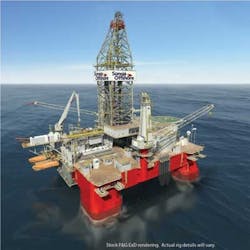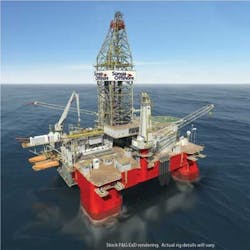Ian Thom - Wood Mackenzie
The Caspian Sea is the setting for some of the world’s oldest offshore oil developments. These date to the late 1940s in Azerbaijan, when the Pirallahi, Gurgany Deniz, and Chilov Adasy fields were brought onstream. Azerbaijan remained a prominent offshore producer through the 1950s and, for a while, the Neft Dashlary field took on the mantle of the world’s biggest offshore project.
Despite this early success, over the next 40 years Azeri exploration and production failed to extend much beyond the shallow water Absheron Peninsula area. The priorities of the Soviet state shifted onshore to reserves in the West Siberian basin, and the indigenous industry lacked the technology, experience, and inclination to invest in the known giant reserves of the deeper water Caspian.
Fast-forward to the collapse of the Soviet Union in the early 1990s, when the Caspian was restored to its place of prominence in the international offshore industry. The newly independent states of Azerbaijan, Kazakhstan, and Turkmenistan sought partnerships with international oil companies to develop their natural resources and to provide much-needed revenue for the bankrupt, fledgling states. Now, less than 20 years later, the Caspian offshore is one of the world’s most important sources of oil and gas production growth. In 2010, offshore production is expected to top 1.5 MMboe/d, with plans in place to reach 3 MMboe/d by 2020.
Three giant offshore fields – Azeri-Chirag-Guneshli (ACG), Shah Deniz, and Kashagan – account for the majority of oil and gas investment, and about two-thirds of remaining reserves. ACG and Shah Deniz are providing steadily increasing revenues to the Azeri state and its international partners, while critical new regional infrastructure has been installed in the form of the Baku-Tbilisi-Ceyhan and South Caucasus pipelines. In Kazakhstan, the Kashagan field is expected to export its first oil in 2013, with construction of a major new export pipeline anticipated for full field development. These new pipelines will unlock reserves in the giant fields while acting as a catalyst for myriad smaller projects which will be ready for development over the next two decades.
There are currently 10 major Caspian offshore oil and gas developments. In addition, there are two recent discoveries in the Russian sector – Morskaya and Tsentralnaya – that should progress to development over the next 10 years. There have been no significant discoveries (or drilling, for that matter) to date in the Iranian Caspian.
Total capital expenditure over the past five years was $38 billion, and this is set to increase to $55 billion for the next five. Over the whole period, Kashagan, ACG, and Shah Deniz will account for 47%, 23%, and 15% of expenditure, respectively.
The majority of offshore fields have been developed using fixed platforms, in water depths up to 175 m (574 ft). Subsea manifolds were first used in 2008 for water injection at the deepwater Guneshli field, while subsea technology will likely feature also in the first two phases of the Shah Deniz gas field development.
In Kazakhstan, artificial islands are being built at Kashagan field, which lies in water depths of 1-5 m (3.3-16.4 ft), and development drilling will employ land rigs. This novel, but expensive, approach was necessitated by the fact that the northern Caspian freezes over in the winter and conventional platforms would be at risk from shifting ice.
The Diyarbekir field on the Livanov block in Turkmenistan already produces oil from a mobile production unit, although fixed platforms will be required for full-field development. New fields, such as Tsentralnaya in 500 m (1,640 ft) of water, will require more bespoke subsea solutions, given the difficulty in bringing pre-assembled equipment into the Caspian and constraints on yard capacity.
ACG
The giant ACG field contributes over 1% of global oil supply. It was discovered in 1979, although the production sharing agreement (PSA) was only signed in 1994, with first production three years later. The development comprises five fixed platforms, a large processing facility onshore with oil exported through the 1 MMb/d, Baku-Tbilisi-Ceyhan pipeline. Production has increased steadily since 2005, and is approaching its plateau level of around 1 MMb/d. Subsea tiebacks are installed in the deeper water parts of the Guneshli field, and are the first examples of this technology in the Caspian Sea.
The project partners are BP (34.14% and operator), Chevron (10.28%), INPEX (10%), SOCAR (10%), Statoil (8.56%), ExxonMobil (8%), TPAO (6.75%), Devon Energy (5.63%), Itochu (3.92%), and Hess Corp. (2.72%). Reserves of around 5.4 Bbbl of oil should be produced within the contract period. A further billion barrels of reserves could be added with development of the Balakhany reservoirs, and by enhanced recovery from existing pay zones.
Shah Deniz
Gas from the giant Shah Deniz gas-condensate field is exported to Georgia and Turkey, and ultimately could reach the European market. The field was discovered in 1999 and began production in 2006 from a jackup platform. Well output has averaged 175 MMcf/d. The project partners are BP (25.5%), Statoil (25.5%), LUKoil (10%), National Iranian Oil Co. (10%), SOCAR (10%), Total (10%), and TPAO (9%). The project is jointly operated by BP and Statoil. BP is responsibile for the operations while Statoil manages the commercial aspects of Phase 1 contracts.
The field has commercial reserves of over 22 tcf of gas, although only 6.6 tcf is contracted under the first development phase. The operator plans a second phase, which is yet to be sanctioned, to involve construction of an additional platform and subsea facilities to recover of another 10-15 tcf. Gas from the second phase is hotly sought after by a number of competing pipeline projects vying to supply the European market.
Kashagan
The super-giant Kashagan field, largest in the Caspian, is huge even in global terms, with an estimated 13 Bbbl of oil reserves. Its development is proving to be one of the world’s largest and most complex engineering projects. It was discovered in 2000 and is part of the North Caspian Sea PSA. The first development phase is under way, and production is expected to begin in 2013. The field is expected to produce 1.5 MMb/d at plateau, around 10 years after first oil, although these later phases have to be sanctioned by the partners and government, and are subject to huge uncertainties over timing and cost.
The partners are Eni (16.81%), ExxonMobil (16.81%), KazMunaiGas (16.81%), Shell (16.81%), Total (16.81%), ConocoPhillips (8.4%), and INPEX (7.56%). The project operator is North Caspian Operating Co. (NCOC). It is responsible for general management but some of the individual partners have specific roles. Eni is responsible for Phase 1 development until first oil. Thereafter, Shell will have the offshore operations role for Phase 1 and the offshore development role in further phases.
Other current/future projects
Other significant offshore projects are at various stages of development. The Cheleken, Livanov, Shah Deniz, and SOCAR assets are onstream, while the Severnyi area should begin production this year. Thereafter, there is a gap to Kalamkas More and Pearls, which could start-up in 2018. The Morskaya and Tsentralnaya fields remain under appraisal, with uncertainty over their production schedule.
The Caspian Sea has several unique challenges which constrain the pace of oil and gas development. These include limited access to rigs, overstretched fabrication yards, restricted equipment access via the Volga-Don canal (iced over during winter months), distance to export markets, and strict environmental regulations. In addition, disputed maritime borders prevent exploration in parts of the southern Caspian Sea. Projects in each littoral state compete for available rigs, yard space, and pipeline capacity.
Given these issues, many of the projects are characterized by long lead times and have increased costs relative to similar international projects. Despite this, the sheer size of the resource means that the sector has substantial medium- and long-term potential, although the commercial challenges means that the Caspian offshore is generally a large company play – at least while major infrastructure is being developed.
The Caspian offshore is a key global source of oil and gas production growth. Liquids production has increased from 300,000 b/d in 2004 to 1 MMb/d in 2009, and is expected to reach 2.6 MMb/d by 2022. Gas production has increased from 465 MMcf/d in 2004 to 1.67 bcf/d in 2009, and could increase to 6.3 bcf/d in 2024, as several projects reach their plateau output. The Shah Deniz, Livanov, and Severnyi areas will be the main sources of gas.
Short-term oil production is dominated by the ACG field, while Kashagan will come to prominence in the medium to long term. The two fields are at very different stages of development, with ACG currently approaching peak production, and Kashagan due to start up in 2013. The performance of these two fields will have a large impact on the overall Caspian total.
Upstream rankings
As of Jan. 1, 2010, BP has the most valuable upstream portfolio (amongst international companies) in the Caspian offshore sector due to its stakes in ACG and Shah Deniz. ExxonMobil and Total occupy second and third position, although neither has a major operated project, while the main Kashagan partners occupy positions two through six. For comparison, the cumulative remaining value (NPV10) to the four littoral states amounts to $280 billion – a factor of 20 greater than BP.
LUKoil ranks highest in terms of remaining reserves, due to its stakes in Severnyi block, Khvalynskoye, and Shah Deniz. This contrasts to its eighth place in value terms – a contrast which reflects the early stage of the Severnyi development (with major expenditures still to come), its liability for Russian oil export duty, and the large proportion of gas reserves. The main Kashagan partners also rank highly, along with BP and SOCAR.





